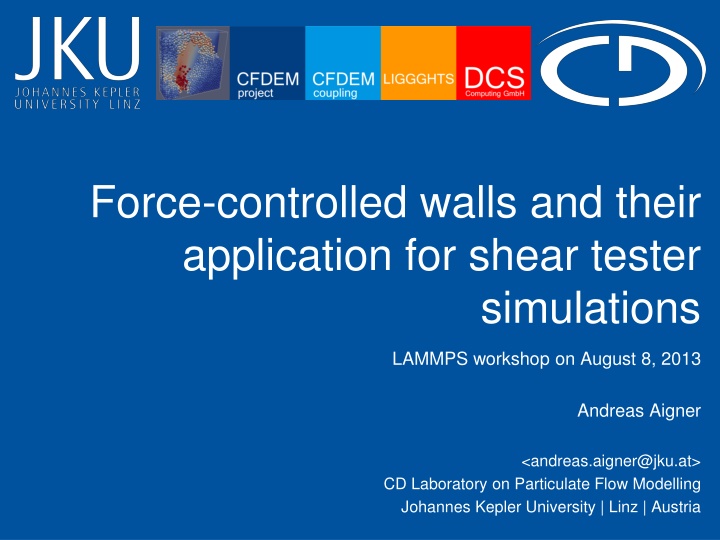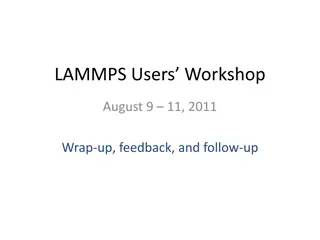
Shear Tester Simulations Using Force-Controlled Walls
Explore the application of force-controlled walls in shear tester simulations, including material properties, experimental setups, and numerical modeling. Gain insights into coefficient of friction determination and the Jenike shear tester. Join the LAMMPS workshop for practical knowledge.
Download Presentation

Please find below an Image/Link to download the presentation.
The content on the website is provided AS IS for your information and personal use only. It may not be sold, licensed, or shared on other websites without obtaining consent from the author. If you encounter any issues during the download, it is possible that the publisher has removed the file from their server.
You are allowed to download the files provided on this website for personal or commercial use, subject to the condition that they are used lawfully. All files are the property of their respective owners.
The content on the website is provided AS IS for your information and personal use only. It may not be sold, licensed, or shared on other websites without obtaining consent from the author.
E N D
Presentation Transcript
Force-controlled walls and their application for shear tester simulations LAMMPS workshop on August 8, 2013 Andreas Aigner <andreas.aigner@jku.at> CD Laboratory on Particulate Flow Modelling Johannes Kepler University | Linz | Austria
Outline Material properties Jenike shear tester Basic idea Experimental set-up Numerical model What LIGGGHTS already can Force controller Comparison of experimental and numerical results Conclusions 2 August 5, 2013 | Christian Doppler Laboratory on Particulate Flow Modelling | www.jku.at/pfm
Material properties Commonly used DEM contact models are spring-dashpot Material properties for Hertz model Radius [R] Mass [m] Young s modulus [E] 1 5 15 ????2 16 ?????? Poisson s ratio [ ] ??,?????=16 ?????? 15 4 3??? ????? Coefficient of restitution Coefficient of friction [ r] ??,?????= ?? ???? 3 August 5, 2013 | Christian Doppler Laboratory on Particulate Flow Modelling | www.jku.at/pfm
Method Determination of the coefficient of friction by means of a comparison of experimental and simulation results of a simplified Jenike shear tester Average of several experimental runs Numerical results for varying coefficient of friction Compare of the steady-state flow xz/ z xz/ z Time (s) Time (s) 4 August 5, 2013 | Christian Doppler Laboratory on Particulate Flow Modelling | www.jku.at/pfm
Jenike shear tester Shear cell of the Jenike shear tester (from Schulze D., Flow Properties of Powders and Bulk Solids, 2011) 5 August 5, 2013 | Christian Doppler Laboratory on Particulate Flow Modelling | www.jku.at/pfm
Experimental set-up Requirements for the numerical simulation: Motion of one ring with constant velocity Determination of the force acting on the rings A constant normal force has to be applied to the particles Scatch of the simlified Jenike shear tester used for experiments. 6 August 5, 2013 | Christian Doppler Laboratory on Particulate Flow Modelling | www.jku.at/pfm
Numerical simulation The shear cell consists of a lid and two rings Therefore triangulated meshes are imported 7 August 5, 2013 | Christian Doppler Laboratory on Particulate Flow Modelling | www.jku.at/pfm
What LIGGGHTS already can.. A triangulated mesh can be moved and rotated with variable or constant velocity and angular velocity, respectively. All forces and torques acting on one geometry are calculated and accessible in the input script fix cad1 all mesh/surface/stress file mesh/upperCyl.stl type 2 scale 0.001 move 0. 0. 0. com 0. 0. 0. variable FxCad1 equal f_cad1[1] variable FyCad1 equal f_cad1[2] 8 August 5, 2013 | Christian Doppler Laboratory on Particulate Flow Modelling | www.jku.at/pfm
Force controller PID-controller with anti-windup mechanism maximum velocity limiter ? ?????? = ??? ? + ?? ? ? + ????????? ??????? 1 ?=0 This approach can also be used to control the torque by replacing force and velocity by torque and angular velocity. 9 August 5, 2013 | Christian Doppler Laboratory on Particulate Flow Modelling | www.jku.at/pfm
Numerical set-up 10 August 5, 2013 | Christian Doppler Laboratory on Particulate Flow Modelling | www.jku.at/pfm
Check the servo-wall Normal stress applied by the servo-wall These results are achieved with a pure proportional controller: The normal stress is kept constant Only a small overshoot at the first particle-wall contact z(Pa) Time (s) 11 August 5, 2013 | Christian Doppler Laboratory on Particulate Flow Modelling | www.jku.at/pfm
Results Example for glass beads with r = 0.25 mm Ratio shear stress / normal stress versus time Time (s) Time (s) 12 August 5, 2013 | Christian Doppler Laboratory on Particulate Flow Modelling | www.jku.at/pfm
Conclusions A force controlled servo-wall was implemented into the framework of LIGGGHTS This new wall type provides a constant normal stress for the simulation of a simplified Jenike shear tester. By comparing experimental and numerical results the coefficient of friction is determined for individual granular material. 13 August 5, 2013 | Christian Doppler Laboratory on Particulate Flow Modelling | www.jku.at/pfm
Thank you. Questions? Johannes Kepler University Linz CD Laboratory on Particlulate Flow Modelling Contact: andreas.aigner@jku.at

